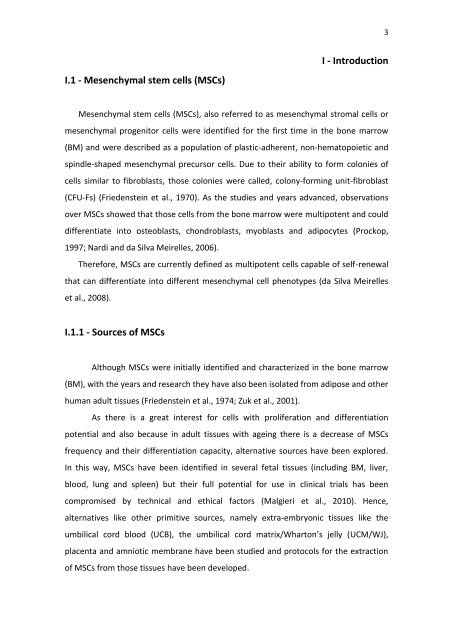DEPARTAMENTO DE CIÊNCIAS DA VIDA ... - Estudo Geral
DEPARTAMENTO DE CIÊNCIAS DA VIDA ... - Estudo Geral
DEPARTAMENTO DE CIÊNCIAS DA VIDA ... - Estudo Geral
Create successful ePaper yourself
Turn your PDF publications into a flip-book with our unique Google optimized e-Paper software.
3<br />
I - Introduction<br />
I.1 - Mesenchymal stem cells (MSCs)<br />
Mesenchymal stem cells (MSCs), also referred to as mesenchymal stromal cells or<br />
mesenchymal progenitor cells were identified for the first time in the bone marrow<br />
(BM) and were described as a population of plastic-adherent, non-hematopoietic and<br />
spindle-shaped mesenchymal precursor cells. Due to their ability to form colonies of<br />
cells similar to fibroblasts, those colonies were called, colony-forming unit-fibroblast<br />
(CFU-Fs) (Friedenstein et al., 1970). As the studies and years advanced, observations<br />
over MSCs showed that those cells from the bone marrow were multipotent and could<br />
differentiate into osteoblasts, chondroblasts, myoblasts and adipocytes (Prockop,<br />
1997; Nardi and da Silva Meirelles, 2006).<br />
Therefore, MSCs are currently defined as multipotent cells capable of self-renewal<br />
that can differentiate into different mesenchymal cell phenotypes (da Silva Meirelles<br />
et al., 2008).<br />
I.1.1 - Sources of MSCs<br />
Although MSCs were initially identified and characterized in the bone marrow<br />
(BM), with the years and research they have also been isolated from adipose and other<br />
human adult tissues (Friedenstein et al., 1974; Zuk et al., 2001).<br />
As there is a great interest for cells with proliferation and differentiation<br />
potential and also because in adult tissues with ageing there is a decrease of MSCs<br />
frequency and their differentiation capacity, alternative sources have been explored.<br />
In this way, MSCs have been identified in several fetal tissues (including BM, liver,<br />
blood, lung and spleen) but their full potential for use in clinical trials has been<br />
compromised by technical and ethical factors (Malgieri et al., 2010). Hence,<br />
alternatives like other primitive sources, namely extra-embryonic tissues like the<br />
umbilical cord blood (UCB), the umbilical cord matrix/Wharton’s jelly (UCM/WJ),<br />
placenta and amniotic membrane have been studied and protocols for the extraction<br />
of MSCs from those tissues have been developed.
















